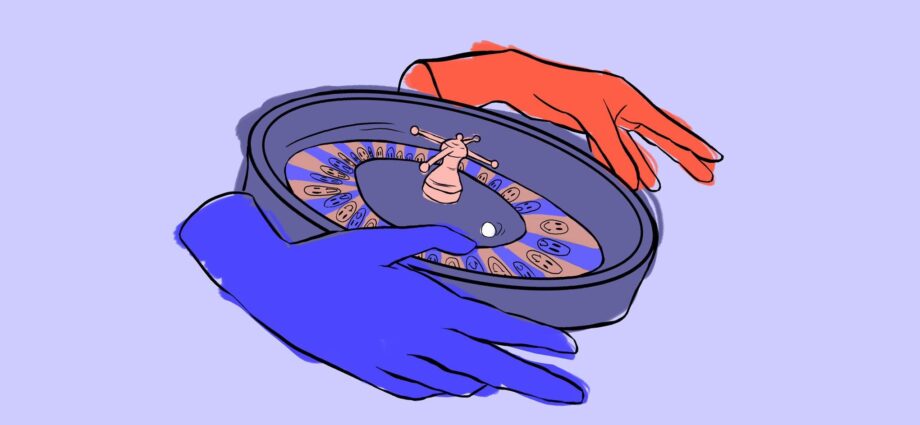By NVM
Emotions are a key factor when we make choices on a daily basis. For example, the decision of whether to cook dinner or simply order pizza can be influenced not only by the ingredients we have at home and our budget. Maybe the kitchen is a mess and only thinking of having to cook there makes us feel disgusted. Or just the simple thought of having a hot pizza elicits joy and happiness. However, what happens when these emotions are not even related to the decision itself? And how do our emotions influence our willingness to take risks, for example when gambling?
To better understand emotions in decision-making, we first need to look at two different forms of emotion (Zhao et al., 2016):
- Integral emotions are directly related to the decision or situation at hand. This means that the emotion a person feels is caused by the decision itself.The case of the pizza-ordering decision above provides examples of such emotions. In this situation, disgust is felt directly due to the decision whether to cook or not. It is not because of any unrelated event that happened earlier during the day.
- Incidental emotions are irrelevant and unrelated to the decision. An example would be if we are already in a bad mood in the pizza-ordering case because we received a bad grade at university or had an argument with our boss at work.
Interestingly, various studies showed that such incidental or unrelated emotions can change how we make decisions and to what extent we are willing to take risks (for example Winkielman et al., 2005; Yuen & Lee, 2003; and Zhao et al., 2016). In one experiment by Zhao et al. (2016), participants were asked to gamble and could choose between
- a small amount of money, which resulted in a small loss but also in a small gain or
- a larger amount of money, which resulted in a bigger loss but also a bigger gain.
At the time the participants had to decide, either a positive, a neutral, or a negative picture appeared. These pictures tried to elicit incidental emotions by being unrelated to the actual gambling decision.
Zhao et al. (2016) demonstrated that participants preferred riskier decisions when seeing positive images during the decision-making process. This means that there seems to be evidence for a connection between positive incidental emotions and a higher willingness to take risks. In other words, when we are in a good mood, we are less risk-averse and more willing to take some risks, even when the source of our good mood has nothing to do with the risky decision. This finding is also supported by a similar study by Winkielman et al., 2005. Furthermore, an experiment by Yuen and Lee (2003) also discovers a connection between negative emotions and more risk-avoidant decision-making. This suggests that when we are in a negative or depressed emotional state, we try to avoid risks and play it safe, even when the emotion is completely unrelated to the decision-making process.
These effects of incidental emotions on risk-perception and decision-making might be linked to the assumption that persons in a more positive mood are more optimistic about the future while others in negative or bad moods make more pessimistic judgements (Lerner et al., 2015). This is called the carry-over effect, in which emotions from one situation also influence subsequent but unrelated decisions and judgements.
However, recent research by Yang et al. (2020) suggests that the actual effect on our decision-making processes might vary depending on the specific emotion induced. Their findings show that fear leads to more risk-averse decisions while anger does, although both of these are negative emotions. Illustrating the details of this research would go beyond the scope of this article, but might be an interesting topic to cover in the future.
Being aware of the effects of emotions on risk decisions can help us to identify situations, in which we might not act fully rationally, but do some emotional gambling instead. The next time we are in a situation regarding risk-calculation, we may be able to think of our current mood influencing our thought process, which can help us make better decisions. Although not an actual risk decision, consider the pizza case again. If you are ever in this situation, ask yourself: Why do you want to order pizza? Is your decision based on the actual thing, namely to have a nice warm pizza? Or are there other emotions you encountered during the day that are completely unrelated to the question whether to order pizza or not, but still affects your decision? However, no matter the reasons for your decision: Enjoy your well-deserved pizza!
Edited by Joanna Sowińska, artwork by Mira Kurtovic
References:
Lerner, J. S., Li, Y., Valdesolo, P., & Kassam, K. S. (2015). Emotion and decision making. Annual Review of Psychology, 66(1). 799-823. https://doi.org/10.1146/annurev-psych-010213-115043
Winkielman, P., Berridge, K. C., & Wilbarger, J. L. (2005). Unconscious affective reactions to masked happy versus angry faces influence consumption behavior and judgements of value. Personality and Social Psychology Bulletin, 31(1), 121-135. https://doi.org/10.1177/0146167204271309
Yang, Q., Zhou, S., Gu, R., & Wu, Y. (2020). How do different kinds of incidental emotions influence risk decision making? Biological Psychology, 154, 1-8. https://doi.org/10.1016/j.biopsycho.2020.107920
Yuen, K. S. L., & Lee, T. M. C. (2003). Could mood state affect risk-taking decisions? Journal of Affective Disorders, 75, 11-18. https://doi.org/10.1016/S0165-0327(02)00022-8
Zhao, D., Gu, R., Tang, P., Yang, Q., & Luo, Y.-J. (2016). Incidental emotions influence risk preference and outcome evaluation. Psychophysiology, 53, 1542-1551. https://doi.org/10.1111/psyp.12694

